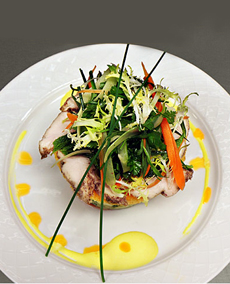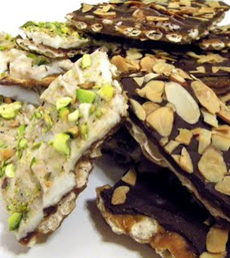|
Looking for dinner salad ideas? Look no further than this alluring interpretation we had at Orsay, a restaurant in Manhattan that specializes in classic brasserie fare (with some modern dishes like this French-style “dinner salad”).
You can also serve it as a luncheon salad, or as a first course to a larger meal.
The concept is simple: Cook your protein and top it with a salad of dressed baby lettuces. Here’s the easy recipe template:
1. BASE LAYER: VEGETABLE OR STARCH. In the photo, a round of roasted winter squash is used as the base. Instead of squash, you can use any starch or vegetable: rice, mashed white or sweet potatoes, cucumber salad, tabbouleh or your favorite braised, grilled, steamed, sautéed or grilled vegetables (we like sautéed spinach or kale). If you want more salad, use salad as the base. Or, you can skip the base entirely.
|
|

Lemon-mango chicken salad. Photo courtesy Orsay Restaurant | New York City. |
2. MIDDLE LAYER: PROTEIN. Slice the protein and set it atop the base. You can use just about any protein: meat, poultry, grilled or poached salmon, other fish or seafood, or vegetable protein such as seitan or tempeh.
3. TOP LAYER: SALAD. We buy mixed baby greens (mesclun) and snip in some fresh herbs, typically basil, cilantro or parsley. You can use one lettuce, such as frisée or radicchio, or whatever appeals to you at the market.
4. OPTIONAL SAUCE. Serve with lemon mayonnaise (add 1 teaspoon fresh lemon juice to 1/2 cup mayonnaise), aioli (garlic mayonnaise, or a mustard-mayonnaise blend [use Dijon or grainy mustard]). The chef at Orsay added drops of mango purée to create a lemon-mango sauce.
5. OPTIONAL GARNISH. Use chives, shaved Parmesan curls, crumbled blue or goat cheese, or whatever you have in house, from an artichoke heart or water chestnuts, to a strip of grilled red pepper for color. A bit of fresh fruit also works: a slice of apple or mango, a halved grape or even crispy dried apple chips.
Have fun playing with the template.
Find more of our favorite salad recipes.
|




